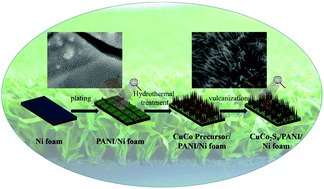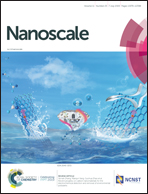In situ confined vertical growth of a 1D-CuCo2S4 nanoarray on Ni foam covered by a 3D-PANI mesh layer to form a self-supporting hierarchical structure for high-efficiency oxygen evolution catalysis†
Abstract
Inspired by the patchwork of artificial turf, where planting in a smaller area can result in a more uniform lawn that grows in one direction, here, we defined the growth position and orientation of a CuCo2S4 nanoarray for the first time by electroplating a PANI mesh layer onto a Ni foam to obtain a self-supporting hierarchical electrode material. The nitrogen species derived from the PANI building blocks act as bridging sites to bind with metal ions, which provides a strong coupling effect for the in situ growth of CuCo2S4. At the same time, the mesh structure of PANI divides the growable location into smaller blocks. Compared with a mesh plane with uniformly distributed nitrogen sites, only a small portion of the nitrogen sites are located on the narrow-width fence structure, which may make it difficult for CuCo2S4 to grow onto the fence structure, thereby limiting the self-growth space and confining CuCo2S4. The uniformly distributed growth sites direct CuCo2S4 to grow perpendicular to the plane while limiting their growth size. The excellent structural features further enhance the electrochemical oxygen evolution activity, and the oxygen evolution overpotential at a current density of 100 mA cm−2 is only 291 mV, which is superior to that of the currently known cobalt–copper-based catalyst materials. In addition, the stable structure provides excellent electrode cyclic stability. The preparation of hierarchical self-supporting cobalt–copper bimetallic sulfide nanoarrays provided a reference direction for other transition metal catalytic materials and provided a basis for industrial applications.



 Please wait while we load your content...
Please wait while we load your content...